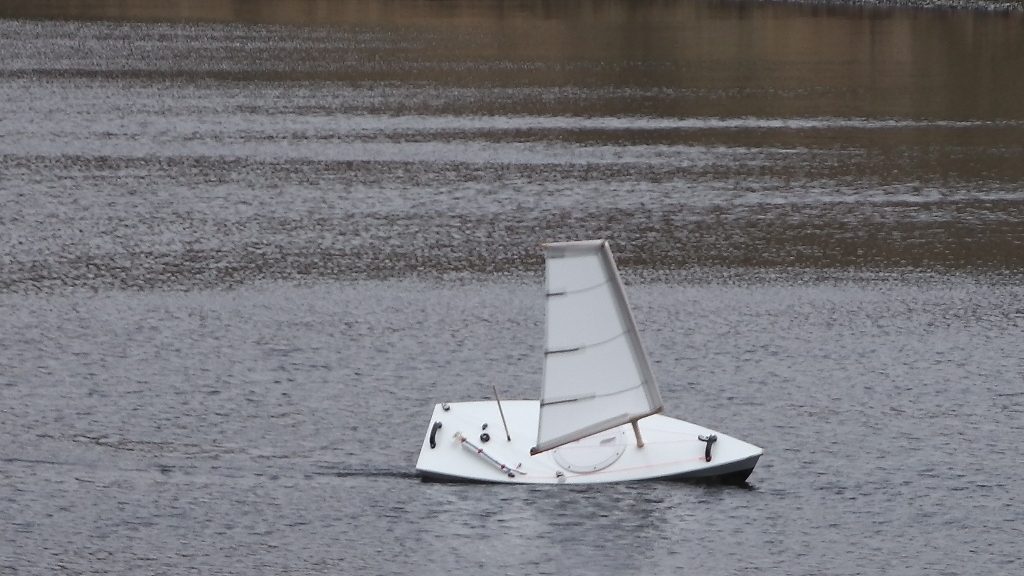
Aberystwyth University
About us
We represent research staff from the Intelligent Robotics Group at the Department of Computer Science in Aberystwyth University. We have been working on autonomous surface vehicles since 2004 and have built over 15 sail powered and 2 motorised robots in that time. In 2010 we were the first team to attempt the Microtransat Challenge.
Our Robots at WRSC2013
We aim to bring 3 robots to WRSC2013 (assuming they are all working!). There will be a 1.2 metre long MaxiMOOP sailing robot « Morwyn dod Cantre’r Gwaelod », the 2 metre long hybrid sail and motor boat ARRTOO and the motor boat Minty2.
Morwyn dod Cantre’r Gwaelod
The name « Morwyn dod Cantre’r Gwaelod » is Welsh for « Maiden of Cantre’r Gwaelod ». Cantre’r Gwaelod was a mythical Welsh kingdom in what is now Cardigan Bay to the West of Aberystwyth. It has been dubbed the Welsh Atlantis and according to the legend was protected by a series of sluice gates but was flooded by accident when the gatekeeper got drunk and forgot to close them on the incoming tide.
Morwyn is one of a pair of MaxiMOOP boats that we have built in the last year, the other is Dewi i’r Ddraig (David the Dragon) which is being used by our student Sailbot Team. Morwyn has a much smaller rig and larger rudder than Dewi and has been designed for long distance sea sailing rather than short distance racing. The MaxiMOOP hull was designed by Professor Paul Miller at the US Naval Academy as an improved and faster version of our earlier 74 cm long MOOP (Miniature Ocean Observation Platform) hull.
Length: 1.2 m
Weight: approx 10 kg
Computers: Two Olimexuino 32U4 (Arduino Leonardo clones) microcontrollers
Communications: Rockblock Iridium 9602 Short Burst Data modem and optional Xbee
Batteries: 4x 7.4V 5.5aH LiPo batteries for the actuators and 4x 3.7V 5aH LiPO batteries for the computers.
Wind sensor: Rotary magnetic sensor based on the Austria Microsystem AS5040 magnetic position encoder
GPS: Globalstar EM408 SiRF3
Compass: Honeywell HMC6343
Actuators: Hitec HS-5646WP waterproof servo for the rudder and Smartwinch RMG 280 EL sail winch.
Other sensors: Salinity probe, water and air temperature sensors

ARRTOO
ARRTOO (Autonomous Robot for Rapid Transit and Ocean Observation) is the latest addition to our robotic fleet and is our first hybrid sailing and motor boat. It was built in response to a call for designs from the Natural Environment Research Council and Defence Systems Technology Laboratory for a boat capable of travelling at speeds of up to 10 knots to a site of interest and then remaining there for an extended period of time. ARRTOO is only a half sized demonstrator of the boat intended to fill this role. ARRTOO is based on a design for a fishing boat that is designed to travel both under sail and motor fairly efficiently. She is propelled by a single model aircraft electric motor and can retract her keel and lower her sails for motoring.
Length: 1.95 m
Weight: 30 kg
Top speed: 6.4 knots under motor, 4.5 knots under sail.
Actuators: Smartwinch 380 EL sail winch, Futaba S3306MG servo for rudder control, Graupner Sail winch 4 for raising and lowering the sails, 12V DC motor for operating a lead screw to raise and lower the keel.
Propulsion: 700 W 3 phase model aircraft motor.
Other sensors: YSI 6600-V2 multiparameter sonde for measuring water salinity, turbidity, temperature, dissolved oxygen and chlorophyll content.
The control system has been copied from Morwyn and uses the same compass, GPS, microcontrollers and code.

Minty2
Minty2 is a motorised unamnned surface vehicle designed to survey calving glaciers in Greenland with high resolution SONAR and a 3D Laser Scanner. Minty2 replaces Minty1 which was a remote control boat based on an Optimist dinghy hull. The hull was specially designed by Professor Paul Miller of the US Naval Academy to push ice aside, to fit the SONAR transducers into the hull and to go faster than Minty1.
Hull construction: Plywood and aluminium covering the front half of the boat for ice protection.
Length: 2.5 metres
Weight:
Top speed: Approximately 3-3.5 knots (5.5-6.5 kM/H)
Computers: Two Fit PC 1.6 gHz Intel Atom systems, one running Ubuntu Linux and the control system, the other running Windows 7 and the survey equipment.
Motor Controllers: Two 4QD 40-12 analogue motor controllers, controlled by a Labjack U6 connected to the control PC.
Navigation sensors: Garmin GPS-18LVC, Furuno PG-500 Fluxgate compass and a Honeywell HMC6343 solid state compass for the navigation system. Hemisphere Cresecent Vector GPS compass and an RTK/DGPS survey grade GPS for the survey systems.
Batteries: 3x 90 aH 12 V LiFeYPO4 electric vehicle batteries, enough for about a 20 km journey. Charged by an onboard petrol powered generator.
Communications: 455 mHz radio modem for control system telemetry, Wifi for remote access to the survey PC and a 5.8 gHz video transmitter for the camera system.
Other sensors: SWATH Plus high resolution SONAR and (not currently available) a long range 3D laser scanner. GoPro Hero2 video camera. Inductive current sensors and an Attopilot voltage sensor.
Motors: 2x Minn Kota Riptide RT45 electric trolling motors
